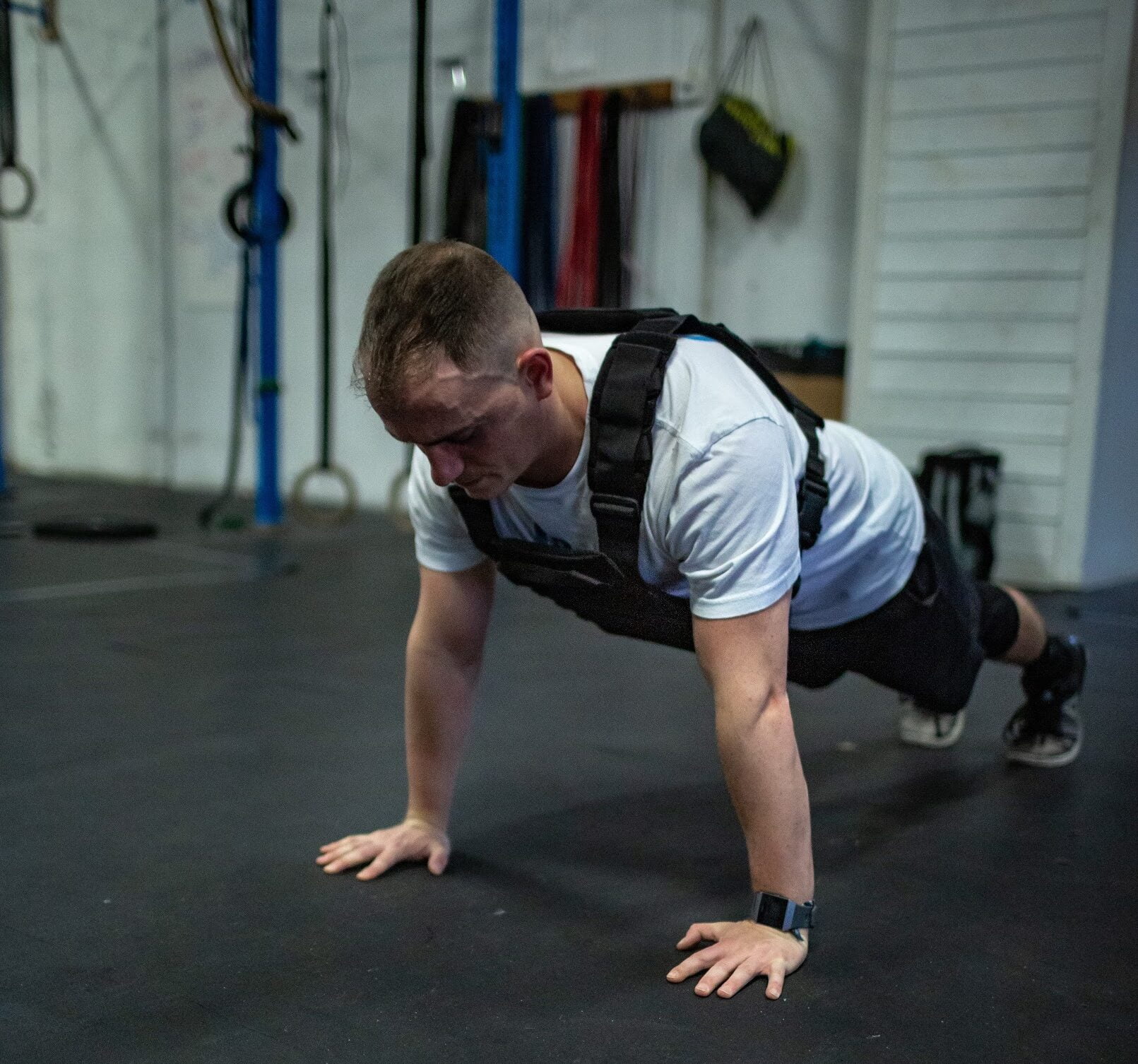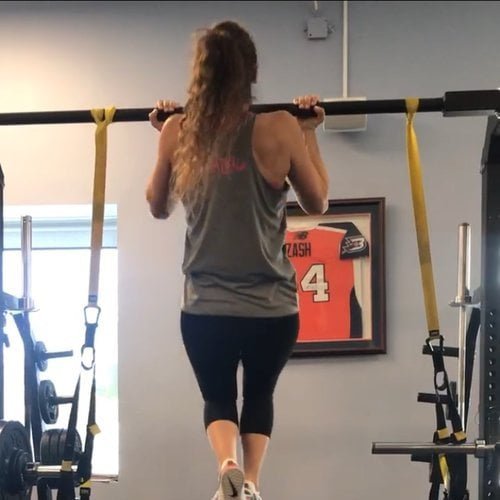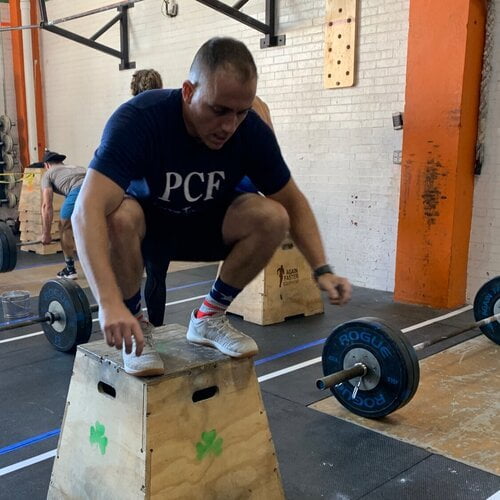The 19 Best (New) CrossFit Benchmark Workouts For Beginners
As an affiliate partner of various brands and sponsored content, WillPower Strength & Nutrition may earn commission on qualifying purchases at no additional cost to you.
If you are new to CrossFit as many of my 1:1 Pain-Free Performance clients are, you may be wondering how to know if you are actually getting better or what the best CrossFit benchmark workouts are for you to assess your fitness level. CrossFit workouts operate on the principle that what gets measured gets improved. If you want to improve your fitness level, setting baselines on what you can do is a great way to ensure that you are getting better over time.
For a baseline assessment to be useful for you then it needs to be both valid and reliable. For a test to be valid it actually needs to test what you intend to measure. For instance, you wouldn’t test your strength by running a mile for time. This is because the mile run is testing your ability to run and the energy system that dominates that time domain. It is not assess force production.
For a test to be reliable, it needs to be able to be repeated in the same fashion and under the same circumstances that it was originally tested for every testing session thereafter. For instance, if you were to use a test including max reps of overhead squats in a sixty-second time frame prior to starting a training program and the first time you performed the test you were above parallel yet the next time you tested overhead squats you were below parallel that would not be a reliable assessment of the workout because the parameters changed.
It may be a good assessment of overhead squat mobility, but not the performance in a sixty-second workout for max reps.
The Six Original CrossFit Girl Workouts
The original CrossFit benchmark WODs (workout of the day) included six “Girl WODs” to assess the fitness levels of everyone from newer athletes to CrossFit Games athletes.
When CrossFit put these workouts out on their main site, their intentions were twofold. First, they intended to use the workouts to help them design a better training program and second, help CrosFitters assess their fitness on an “irregular” basis throughout the year in their appearance of the “Workout of The Day”.
The original Girl Workouts included:
Angie:
For Total Time:
100 pull-ups
100 push-ups
100 sit-ups
100 squats
Barbara:
5 Rounds For Total Time:
20 pull-ups
30 push-ups
40 sit-ups
50 squats
3 minute rest period between rounds
Chelsea:
Every Minute On The Minute x 30 minutes:
5 pull-ups
10 push-ups
15 squats
Diane:
21-15-9 Reps For Total Time:
Deadlift 225 lbs / 155 lbs
Handstand push-ups
Elizabeth:
21-15-9 Reps For Total Time
Clean 135 lbs / 105 lbs
Ring Dips
Fran:
21-15-9 Reps For Total Time
Thruster 95 lbs
Pull-ups
Why These Benchmark CrossFit Workouts Are Not The Best Option
Although these workouts can provide a unique challenge they may not be the best option for you as a beginner CrossFitter. I don’t believe that these six workouts designed by Greg Glassman, the founder of CrossFit, are the best way for beginners to assess their fitness level for several reasons. First, the original CrossFit Girls workouts include movements, rep schemes and reps of each exercise that don’t lend themselves well to getting good data on these newer athletes.
They also are not great tests for assessing the different aspects of fitness. For instance, the last three workouts (Diane, Elizabeth, and Fran) are all the same rep scheme and if you are someone who can actually do these workouts without needing scaling options, they will all likely be completed in roughly the same amount of time and pace. Thus they are really just different variations of the same test just with different movements.
Many of the movements inside these classic benchmark workouts are those that sit far outside the capabilities of most newer athletes. For example, the workout “Diane” includes Deadlifts and Handstand Push-Ups in a rep scheme of 21-15-9. For those that don’t know, this indicates that you will do 21 then 15, and then 9 reps of each exercise for the best time possible.
The Deadlift is a movement that although foundational, can be quite technical as well be challenging for most beginners to perform at 225 pounds for the men and 185 for the women. If the athlete does have the strength to perform the movement then there’s no telling what fatigue will do to their ability to keep good form with a flat back to keep the spine safe.
In the same vein, the original CrossFit Girls, include high-volume gymnastic skills like pull-ups and ring dips that will likely be out of the capabilities of newer athletes. For example, the workout “Angie” contains 100 repetitions of kipping pull-ups. A movement that many new CrossFitters probably should avoid until they have developed the strength in the shoulder girdle to perform a single strict pull-up, let alone hitting 100 reps as a newer athlete.
In order for these movements to be done in CrossFit workouts properly at high intensity, each of them needs to be learned and then progressed through the stages of skill development if long-term success is your goal.
You can learn more about this progression in my recent article:
The Best Training to Improve Gymnastic Skills In CrossFit
Lastly, none of these such workouts tests aspects of true slow and long Aerobic capacity or training where the prescribed work is at a sustained pace for sixty minutes plus. As well as none of these CrossFit WODs assess absolute strength or the ability for you to express the most amount of force possible.
Given that CrossFit’s primary goal is to “improve work capacity across broad time and modal demands” it makes sense that a strength assessment would be included in the benchmark workouts.
You can learn more about building strength in CrossFit in my recent article:
The Best Program For Building Strength In CrossFit
A Better Option For CrossFit Benchmark Workouts
A better lens to view designing benchmark CrossFit workouts is threefold. They include your training age, your skill level and the different aspects of fitness that you want to test.
We will dive into each one of these as it pertains to CrossFit training in this section so you can get an idea of how I design testing for clients inside my 1:1 Pain-Free Performance Program helping CrossFitters alleviate their pain and elevate their fitness.
Determining your training age is going to be crucial in assessing your fitness prior to starting a training program. As mentioned above, it does not make sense to perform tests that are meant for elite CrossFit athletes when you are a newer athlete who is just getting into high-intensity functional fitness.
Your training experience is going to (usually) dictate how well you can perform certain movements and if certain movements should even be in our workouts to begin with. If you look at one of the original CrossFit girls, the workout “Elizabeth” includes Power or Squat Cleans. These do an excellent job of providing a training stimulus and can give you a great full-body workout.
However, they are also extremely technical and the learning curve can be quite large. If you are new to CrossFit and you simply want to get a baseline fitness assessment (outside of the actual clean itself) to judge progress over time then the technical aspect of this movement will impair both the validity and reliability of the testing since the skill of the movement will prevent you from expressing your fitness level in the test.
In testing (and training) I suggest using cyclical only modalities such as running, using a rower, or biking etc, and then adding in additional elements over time. This would look like adding bodyweight movements to cyclical movements and then lastly adding weights to the cyclical and body weight movements.
Following this progression allows you to build your fitness level and add complexity slowly as you develop resistance training components like the power clean in a non-fatigued setting.
Your skill level will also dictate what types of exercises should be included in your testing. If you look at the workouts Diane or Elizabeth, both of these contain high-level gymnastic movements relative to beginner CrossFitters. If you don’t have these skills you will have to explore scaling options such as Pike Push-Ups for Handstand Push-Ups or Banded Pull-Ups in place of Kipping Pull-Ups.
This is not ideal because as you progress and develop these scores will become invalid as well unless you can recreate the exact position on the Pike Push-Up or use the exact same band for the Banded Pull-Ups the tests are no longer reliable.
Lastly and arguably the most importantly, baseline testing of a training methodology like CrossFit should include all components of human performance. These include aspects of strength, power, muscle endurance, Aerobic capacity and Anaerobic Capacity. As well as various skills that would be seen in a CrossFit WOD.
You can learn more about Aerobic and Anaerobic training for CrossFit in my recent articles:
3 Signs You Are NOT Training Aerobically
VO2 Max vs Lactate Threshold: The Difference, How To Test Them and Why It Matters For Athletes
Using Max Aerobic Speed Concepts To Improve In The Sport of CrossFit
For a beginner CrossFitter whose training experience may be lower, the benchmark CrossFit workouts below are a potential option for you. Although this is in no way exhaustive, you can begin to see examples of what I mentioned above.
Remember, the goal here is to keep testing simple and as low skill-based as possible in fatigued settings like metcons.
Equipment needed for testing:
Strength:
Bench Press
20X1; Work to a 5 rep max
Strict Pull-Up
20X1; Work to a 5 rep max
Back Squat
20X1; Work to a 5 rep max
Deadlift
20X1; Work to a 5 rep max
Rear Foot Elevated Split Squat
20X1; Work to an 8 rep max / leg
Forearm Plank
Max time hold
Muscle Endurance:
Goblet Squat
20X1; Work to a 20 Rep Max
Push-Ups (or HSPU if you have them)
5 Min Max Reps
Strict Pull-Ups (or Ring Row)
5 Min Max Reps
Power:
Box Jump
Build to a max height
Broad Jump
Build to a max distance
Power Clean / Snatch (non-fatigued)
Build to a 3 rep max
Aerobic:
Cyclical:
Assault Bike
10 minutes for max calories
Concept 2 Rower
60 minutes for max meters
Mixed Modal:
10 Rounds For Time:
500-meter row
15 burpees over the erg
90-minute AMRAP
1500 meter row
300-meter bear crawl
200-meter farmers carry
50 single under
Anaerobic:
Cyclical:
Assault Bike
60-second Assault Bike for max calories
Concept 2 Rower
500-meter row for time
Mixed Modal:
21-15-9
Front Squats 95/65
Burpees over bar
*Skill testing for a beginner would be based on if you could accomplish certain movements such as Pull-Ups -> Kipping Pull-Ups -> Butterfly Pull-Ups -> Bar Muscle-Ups etc.
As you can see from the examples above there is a method to the madness. Each piece of the testing is aimed at assessing a specific aspect of your fitness as a beginner CrossFitter. With time this testing body would change and look more like the tests you see in the CrossFit Sanctionals and CrossFit Games. But, as you know now those types of fitness assessments have to be earned in order for them to be considered valid and reliable.
Are the original CrossFit girl workouts “good workouts”? Absolutely, and I perform them throughout the year myself. However “good” refers to what is appropriate for you and of the utmost importance when you are looking to benchmark your fitness.
If you are ready to elevate your fitness without having to deal with nagging pain or injury in the gym, then I invite you to book a risk-free consultation to see how I can help you reach your fitness goals HERE. I am looking forward to chatting with you!







